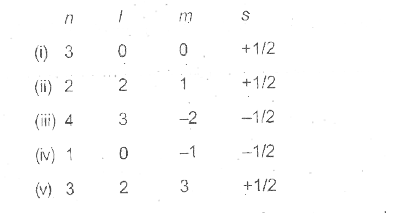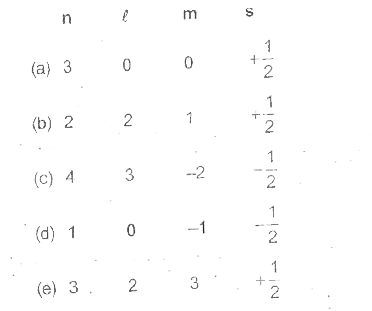Which of the following set of quantum number is are not permitted ?
n=3,l=2,m=−2s=+12
n=3,l=2,m=−1s=0
n=2,l=2,m=+1s=−12
n=2,l=2,m=+1s=−12
To determine which set of quantum numbers is not permitted, we need to understand the rules governing the quantum numbers:
1. Principal Quantum Number (n): This number can take any positive integer value (n = 1, 2, 3, ...).
2. Azimuthal Quantum Number (l): This number can take values from 0 to (n-1). Therefore, for a given n, l can be 0, 1, 2, ..., up to (n-1).
3. Magnetic Quantum Number (m): This number can take values from -l to +l. Thus, for a given l, m can be -l, ..., 0, ..., +l.
4. Spin Quantum Number (s): This number can only be +1/2 or -1/2.
Now, let's analyze the given sets of quantum numbers one by one:
Step 1: Analyze the first set of quantum numbers
- n = 3
- l = 2 (valid since l can be 0, 1, or 2 for n = 3)
- m = -2 (valid since m can range from -2 to +2)
- s = +1/2 (valid since spin can be +1/2 or -1/2)
Conclusion: This set is permitted.
Step 2: Analyze the second set of quantum numbers
- n = 3
- l = 1 (valid since l can be 0, 1, or 2 for n = 3)
- m = -1 (valid since m can range from -1 to +1)
- s = 0 (not valid since spin can only be +1/2 or -1/2)
Conclusion: This set is not permitted due to the spin quantum number.
Step 3: Analyze the third set of quantum numbers
- n = 2
- l = 2 (not valid since l can only be 0 or 1 for n = 2)
- m = 0 (not applicable since l is invalid)
- s = +1/2 (valid but irrelevant since l is invalid)
Conclusion: This set is not permitted due to the azimuthal quantum number.
Step 4: Analyze the fourth set of quantum numbers
- n = 2
- l = 1 (valid since l can be 0 or 1 for n = 2)
- m = 1 (valid since m can range from -1 to +1)
- s = +1/2 (valid since spin can be +1/2 or -1/2)
Conclusion: This set is permitted.
Final Answer
The sets of quantum numbers that are not permitted are:
- The second set (due to the spin quantum number being 0)
- The third set (due to the azimuthal quantum number being 2)
2. Azimuthal Quantum Number (l): This number can take values from 0 to (n-1). Therefore, for a given n, l can be 0, 1, 2, ..., up to (n-1).
3. Magnetic Quantum Number (m): This number can take values from -l to +l. Thus, for a given l, m can be -l, ..., 0, ..., +l.
4. Spin Quantum Number (s): This number can only be +1/2 or -1/2.
- n = 3
- l = 2 (valid since l can be 0, 1, or 2 for n = 3)
- m = -2 (valid since m can range from -2 to +2)
- s = +1/2 (valid since spin can be +1/2 or -1/2)
- n = 3
- l = 1 (valid since l can be 0, 1, or 2 for n = 3)
- m = -1 (valid since m can range from -1 to +1)
- s = 0 (not valid since spin can only be +1/2 or -1/2)
- n = 2
- l = 2 (not valid since l can only be 0 or 1 for n = 2)
- m = 0 (not applicable since l is invalid)
- s = +1/2 (valid but irrelevant since l is invalid)
- n = 2
- l = 1 (valid since l can be 0 or 1 for n = 2)
- m = 1 (valid since m can range from -1 to +1)
- s = +1/2 (valid since spin can be +1/2 or -1/2)
The sets of quantum numbers that are not permitted are:
- The second set (due to the spin quantum number being 0)
- The third set (due to the azimuthal quantum number being 2)
Topper's Solved these Questions
- ATOMIC STRUCTUREBOOK - CENGAGE CHEMISTRY ENGLISHCHAPTER - ATOMIC STRUCTUREEXERCISE - Exercises (Subjective)
52 Videos
- ATOMIC STRUCTUREBOOK - CENGAGE CHEMISTRY ENGLISHCHAPTER - ATOMIC STRUCTUREEXERCISE - Exercises Linked Comprehension
50 Videos
- APPENDIX - INORGANIC VOLUME 1BOOK - CENGAGE CHEMISTRY ENGLISHCHAPTER - APPENDIX - INORGANIC VOLUME 1EXERCISE - chapter-7 Single correct answer
1 Videos
- CHEMICAL BONDING AND MOLECULAR STRUCTUREBOOK - CENGAGE CHEMISTRY ENGLISHCHAPTER - CHEMICAL BONDING AND MOLECULAR STRUCTUREEXERCISE - Archives Subjective
15 Videos
Similar Questions
Knowledge Check
Which of the following sets of quantum numbers is correct for an electron in 4f orbital?
An=4,l=3,m=+4,s=+12Bn=4,l=4,m=−4,s=−12Cn=4,l=3,m=+1,s=+12Dn=3,l=2,m=−2,s=+12
Which of the following sets of quantum number is not possible
View SolutionWhich of the following sets of quantum number is not possible
View SolutionWhich of the following set of quantum numbers is not valid.
View SolutionWhich of the following set of quantum number is possible ?
View SolutionWhich of the following sets of quantum number is allowable
View SolutionConsider the following sets of quantum number

Which of the following sets of quantum number is not possible ?
View SolutionConsider the following sets of quantum numbers

which of the following sets of quantum number is not possible ?
View Solution
